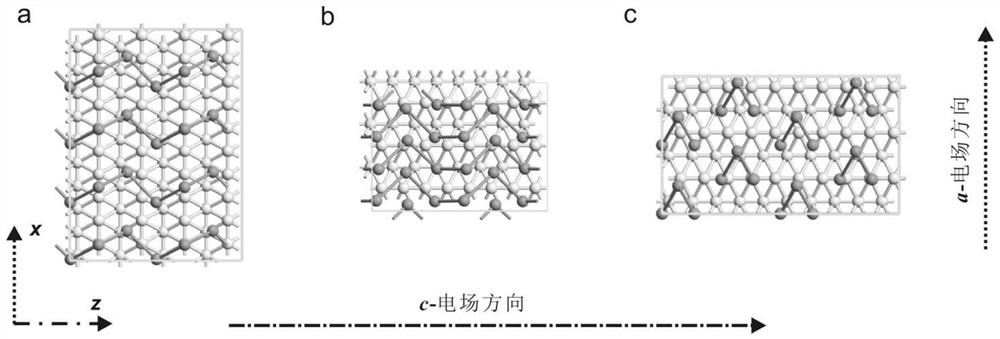Graphene/bilayer tellurene/borene van der Waals heterojunction photodiode device
A photodiode and heterojunction technology, applied in electrical components, semiconductor devices, circuits, etc., can solve the problem of inability to combine high light detection rate and high light responsivity, and achieve the effect of enhancing rectification effect and enhancing light absorption intensity.
- Summary
- Abstract
- Description
- Claims
- Application Information
AI Technical Summary
Problems solved by technology
Method used
Image
Examples
Embodiment 1
[0054] A graphene / double-layer tellurene / borene van der Waals heterojunction photodiode device with a vacuum layer thickness of like figure 1 (b), shown in 10, it is composed of single-layer graphene 1, double-layer tellurene 2 and single-layer borophene 4; the structure of double-layer tellurene belongs to α crystal type, and its crystal lattice orientation is [010] crystal direction;
[0055] The horizontal electric field c-direction coplanar with the bilayer tellurene (the horizontal electric field c-direction is the direction of the electric field applied horizontally along the z-direction of the coordinate axis of the van der Waals heterocrystal cell) is the horizontal direction D, along the horizontal direction D, The bilayer tellurene is composed of m1, m2 and m3 segments from left to right, and the single-layer borophene is composed of n1, n2 and n3 segments from left to right; single-layer graphene and m1 segment form the left electrode region, The length of m2, m3...
Embodiment 2
[0060] A graphene / double-layer tellurene / borene van der Waals heterojunction photodiode device with a vacuum layer thickness of like Figure 11 As shown, it is composed of single-layer graphene 1, double-layer tellurene 2 and single-layer borophene 4; the structure of double-layer tellurene belongs to α crystal type, and its lattice orientation is [010] crystal direction;
[0061] The horizontal electric field a-direction coplanar with the bilayer tellurene (the horizontal electric field a-direction is the direction of the horizontally applied electric field along the x-direction of the coordinate axis of the van der Waals heterocrystal cell) is the horizontal direction D, along the horizontal direction D, The bilayer tellurene is composed of m1, m2 and m3 segments from left to right, and the single-layer borophene is composed of n1, n2 and n3 segments from left to right; single-layer graphene and m1 segment form the left electrode region, The length of m2, m3, n1 and n2 is ...
Embodiment 3
[0066] A graphene / double-layer tellurene / borene van der Waals heterojunction photodiode device with a vacuum layer thickness of like figure 1 As shown in (c) and 12, it is composed of single-layer graphene 1, double-layer tellurene 2 and single-layer borophene 4; the structure of double-layer tellurene belongs to α crystal type, and its lattice orientation is [100] crystal direction;
[0067] The horizontal electric field c-direction coplanar with the bilayer tellurene (the horizontal electric field c-direction is the direction of the electric field applied horizontally along the z-direction of the coordinate axis of the van der Waals heterocrystal cell) is the horizontal direction D, along the horizontal direction D, The bilayer tellurene is composed of m1, m2 and m3 segments from left to right, and the single-layer borophene is composed of n1, n2 and n3 segments from left to right; single-layer graphene and m1 segment form the left electrode region, The length of m2, m3, ...
PUM
 Login to View More
Login to View More Abstract
Description
Claims
Application Information
 Login to View More
Login to View More - R&D
- Intellectual Property
- Life Sciences
- Materials
- Tech Scout
- Unparalleled Data Quality
- Higher Quality Content
- 60% Fewer Hallucinations
Browse by: Latest US Patents, China's latest patents, Technical Efficacy Thesaurus, Application Domain, Technology Topic, Popular Technical Reports.
© 2025 PatSnap. All rights reserved.Legal|Privacy policy|Modern Slavery Act Transparency Statement|Sitemap|About US| Contact US: help@patsnap.com



